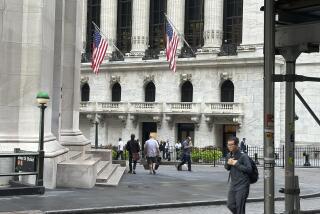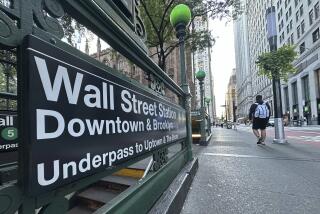Anxiety Trips Up a Recovery on Wall Street
- Share via
Six straight weeks of losses have dragged major stock market indexes to new multiyear lows, but with anxiety over corporate earnings and the prospect of war with Iraq still on the rise, experts are reluctant to say the worst is over.
The Dow Jones industrials and the Nasdaq composite index sank to fresh lows Friday, and the Standard & Poor’s 500 ended just slightly above its July low as conflicting economic data and profit warnings from the likes of Bank of New York Co., EMC Corp., Schering-Plough Corp. and Boeing Co. provided the latest reasons to dump stocks.
“It’s hard for the market to get any confidence,” said Chuck Hill, research director at earnings tracker Thomson Financial/First Call in Boston.
With the S&P; 500 coming off its worst quarter in 15 years and the average domestic stock mutual fund down 17.2% in the three months ended Sept. 30, that’s a common feeling among investors these days.
It didn’t help that the fourth quarter got off to a dismal start, with the S&P; 500 sliding 3.2% last week despite a big bounce Tuesday. The index now is down 30% year to date.
The chief culprit is the rapidly deteriorating outlook for corporate profits, some market pros say.
Analysts’ consensus estimate of year-over-year operating earnings growth in the third quarter for companies in the S&P; 500 has shrunk to 5.9% from 16.6% in early July, Hill said. And fourth-quarter projections are being ratcheted down at a fast clip as well.
“It’s hard for the market to maintain any sustained rally when analysts are slashing estimates like this,” Hill said.
Analysts are reacting in large part to what they are hearing from corporate executives. Among the 5,000 U.S. companies that First Call follows, warnings of profit shortfalls this quarter have outpaced positive “pre-announcements” by 2.4 to 1.
That’s a big change from the first half of the year, when the economy, and earnings, seemed to be on solid recovery tracks.
The ratio of negative to positive earnings pre-announcements was 1.6 to 1 at this point in the second quarter and 1.3 to 1 at this point in the first.
On Friday, aluminum giant Alcoa Inc., the first Dow index company to report its third-quarter results, provided little encouragement, recording its sixth straight drop in quarterly profit.
Third-quarter reporting season heats up starting Oct. 14, but a smattering of reports due this week from General Electric Co., Yahoo Inc., Abbott Laboratories and several regional banks might offer early clues about the broad trends in sales and earnings.
Hill expects S&P; 500 earnings to beat analysts’ expectations by the usual 2 percentage points or so once the third-quarter numbers have been tallied, but he fears that profit reports may be “accompanied by comments about how lousy business is,” which wouldn’t help lift the glum mood on Wall Street.
In its warning Thursday, data-storage company EMC pointed to a “brutal” business climate.
On the economic front, the mixed message of recent weeks continued Friday as the government said nonfarm payrolls fell by 43,000 in September, compared with expectations of a small increase, while the unemployment rate was a better-than-expected 5.6%.
Richard DeKaser, chief economist at National City Corp. in Cleveland, said corporate leaders have adopted a “wait-and-see disposition that yields self-fulfilling results”: Their reluctance to hire workers, make capital investments and launch ventures is keeping economic activity, and thus sales and earnings, restrained.
“The ramp-up in war jitters is the paramount concern” among executives, DeKaser said. He said confidence among executives and investors may not return until there is a clearer sense about what may happen in the U.S.-Iraqi standoff over weapons inspections.
But some experts insist that the economy is in better shape than recent earnings warnings, and falling stock prices, would indicate.
“If you look at the stock market and the corporate bond market you’d think we’re in a recession again. But if you look at the economy you don’t find anything like that,” said Scott Grannis, chief economist at Western Asset Management in Pasadena.
He expects growth to continue at a modest 2% to 3% pace. Because the stock market already has “priced in” a recession, by Grannis’ estimation, share prices could be primed to turn around sooner than later, he said.
“Everybody seems braced for the worst, but we could be seeing the market bottom, or at least the bottoming process,” Grannis said.
If he’s right, that would fit with October’s historical role as a “bear killer.” Some of the worst market declines of the post-World War II era have ended in October.
In a report Friday, Michael Painchaud of Market Profile Theorems, a Seattle-based investment research firm, predicted that the Dow would surge to 11,000 by March. That would be a 46% rise from Friday’s close of 7,528.40.
Painchaud said several signs pointed to a rally: Corporate insiders turned bullish in August, buying shares of their own companies at a brisk pace; the S&P; 500 performance chart from the last three years looks similar to the 1972-74 downturn, which preceded a dramatic rebound; and corporate earnings in 2003 probably will be healthier than the recent spate of warnings suggests, he said.
First Call’s Hill said that although the next couple of weeks could be ugly for the market, later this month investors may start looking optimistically toward 2003, with the hope that earnings by then will be rebounding at a stronger pace.
The market has often bottomed in October in part because investors and company executives begin to shift their focus to the coming year, Hill said.
More to Read
Inside the business of entertainment
The Wide Shot brings you news, analysis and insights on everything from streaming wars to production — and what it all means for the future.
You may occasionally receive promotional content from the Los Angeles Times.










